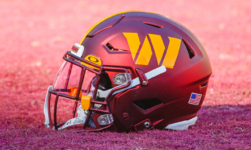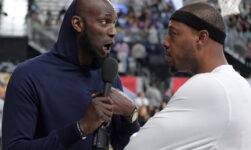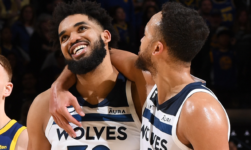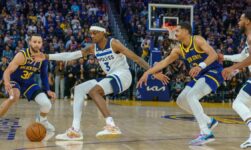In 2011, current Indiana Pacers general manager Kevin Pritchard introduced the concept of the “mediocrity treadmill” to describe the purgatory of winning without contending. Acquiring and retaining good players costs money and assets that can no longer be funneled into the sort of high-upside superstar moves that tend to win championships. It traps your team in a cycle: too good to draft one of those superstars, not good enough to beat them, and too expensive to sign them. For all the effort teams on this treadmill expend, they ultimately get nowhere. A league populated with superteams and well-informed superfans has made their competitors far less tolerant of such inertia. Never has the difference between the haves and have nots been so apparent, and never has the pressure of jumping from one group to the other been greater.
Small-market teams pivoted to ping pong balls for salvation, but their more glamorous counterparts could afford to hoard cap space and trust that superstars would take it, mediocrity be damned. The New York Knicks tried to recruit Kyrie Irving and Kevin Durant in an offseason after finishing with the worst record in the NBA. They punted multiple seasons just for the chance to woo LeBron James in 2010, as did the Miami Heat and Chicago Bulls. Miami was rewarded for its efforts with two championships. There was a shamelessness to it that was almost admirable. The Heat didn’t even pretend to care about the present if they could just hold onto a little bit more flexibility for the future. Why get on a treadmill when you can run toward something?
But take a look at the 2021 offseason. Only three teams spent more than $200 million on free agents: those same Knicks, Bulls and Heat. Yet none of the players they signed made the 2021 All-Star Game. Kyle Lowry and DeMar DeRozan have in the past, but now in their mid-30s, are likely beyond that stage in their careers. These ambitious, big-market vultures aren’t just hopping on this apparent treadmill, they’re paying out the nose for the privilege. Vegas odds place the Knicks and Bulls squarely in the play-in round despite their lavish spending. Caesars Sportsbook pegs the Knicks at 41.5 wins, a ninth-place Eastern Conference finish, while the Bulls are only game higher at 42.5 projected wins. That ties them with the Indiana Pacers for seventh.
Please check the opt-in box to acknowledge that you would like to subscribe.
Thanks for signing up!
Keep an eye on your inbox.
Sorry!
There was an error processing your subscription.
Miami bought itself a bit more championship equity. Lowry is a meaningful improvement upon Kendrick Nunn and Goran Dragic, and P.J. Tucker is the closest they’ve come to replacing Jae Crowder since he left last December. Couple those additions with improvement from incumbent youngsters and the Heat have more top-end talent than they did during their 2020 Finals run. Vegas isn’t convinced. They are a distant fourth in Eastern Conference championship odds at +1200 at Caesars. The Philadelphia 76ers’ situation is volatile, but no credible sportsbook or analytics model has Miami ahead of the Brooklyn Nets or Milwaukee Bucks at this moment. The Heat are in the running, but they’re far from pole position.
The championship likely wasn’t available in the 2021 free-agent market for a multitude of reasons, and the Knicks, Heat and Bulls probably knew that. They spent anyway and defied the post-Decision NBA’s anti-treadmill orthodoxy in the process. Each had its own reasons for doing so. Jimmy Butler is 32 and Miami is running out of time to put a winner around him. Zach Lavine is a year away from free agency and the Bulls need to convince him to stay. The Knicks have been terrible for so long that a No. 4 seed, by their standards, is practically as meaningful as a title. But none feared mediocrity in the way their predecessors did. Nowadays, big-market teams are starting to view it as a prerequisite for superstar additions rather than a hindrance.
The Knicks learned that firsthand when their run at Durant and Irving came up empty. While they were desperately preserving space and tanking for Zion Williamson, the Nets were slowly establishing an organizational identity and developing talent that would supplement elite players. It only took one playoff appearance to sell the two stars on Brooklyn. The Los Angeles Clippers are another instructive example here. They were the laughingstock of the league for several decades, but the Chris Paul-Blake Griffin era changed that. When that team broke up, the Clippers could’ve gone in the tank. Instead, they tried to win and ultimately made the 2019 playoffs. Months later, they landed Kawhi Leonard and Paul George.
Leonard, Durant and Irving all used free agency to get to their new teams, but trades are quickly becoming the weapon of choice for disgruntled All-Stars. The good players and mid-sized contracts that tend to accompany mediocrity help in that respect, both as assets to secure the player and as draws for the player himself. This stands in relative contrast to the first wave of empowered stars, who were comfortable building rosters essentially independently.
James, Dwyane Wade and Chris Bosh were desperate enough to team up in Miami that they played their first season there with little more than minimum-salary free agents to support them. Carmelo Anthony took the same approach in New York with less success, but stars have more frequently sought trades to preexisting winners over the past few years as the novelty of the superteam has worn off. James, Wade and Bosh didn’t need as much surrounding help because they weren’t facing teams that could match their star power. That’s no longer the case. Now, winning a title means beating multiple teams with three superstars, several of whom might fit better than yours, or be healthier than yours, or have more help than yours. Players prefer readymade winners to projects, but much of that in-house talent can get sacrificed in the trade itself. The organizational credibility teams can build just by being decent is more stable.
It’s not a coincidence that rumors are starting to link the Knicks to superstars now, immediately after their best season in ages. Damian Lillard has made the Western Conference finals in Portland. Joining a Knicks roster with little more than himself and Julius Randle as cornerstones likely wouldn’t take him that far again. But the Trail Blazers have had several chances to give him a championship roster. If he eventually does land elsewhere, it is going to be with an organization he trusts to make the sort of big moves it will take to reach the mountaintop. Players didn’t trust the last several Knicks front offices to do that. Last season suggests that they are starting to do so now just as years of winning under Doc Rivers gave George and Leonard the same faith in the lowly Clippers.
This helps answer some of the more pressing questions of the 2021 offseason, especially as it pertains to the treadmill. Chicago’s haul has been met with a surprising degree of ambivalence. The near-consensus belief surrounding the Bulls has been that, while they added a meaningful amount of talent, they’ve sacrificed most of their flexibility for a roster without championship potential, and that as Nikola Vucevic (31 in October) and DeMar DeRozan (turned 32 recently) age out of their primes, the Bulls will be stuck with a roster no longer equipped to win in the present or improve in the future.
Allow me to present an alternative. The Bulls made low-upside, win-now moves because their goal was never to win right now, at least not at the highest levels. The organizational directive at this moment is two-fold: convince Zach LaVine to stay next offseason, and convince someone better to join him down the line. There was no path to championship contention available to them this offseason, so if they wanted to get their eventually, they needed to take an incremental step to not only solidify LaVine’s commitment, but show future targets that they are serious about winning.
Now let’s fast forward a year or two. The Bulls have cemented themselves as a playoff team in the NBA’s third-biggest market. LaVine has signed a long-term extension. Suddenly, Chicago looks a whole lot better to the disgruntled megastars of 2023 and 2024, right? By then, its draft pick commitment to Orlando will likely have expired, giving it more assets to trade. Patrick Williams will have hopefully developed into a budding young star in his own right. DeRozan and Vucevic, even past their prime, could serve as valuable salary filler. If this is indeed the plan, Chicago has potentially given itself the championship equity it apparently lacks. It just isn’t immediately visible yet. They’ve gone from Point A to Point B instead of trying to skip ahead to Point C.
It’s especially notable for the Bulls because four years ago, they answered the exact same question differently. Instead of LaVine as the incumbent star nearing free agency, it was Butler. The Bulls saw no path to building a champion around him, so they traded him in an effort to tank. This time around, they’re displaying more patience. The end goal is title contention. It doesn’t have to come right this minute.
This might be Miami’s solution to its age problem: see what happens now knowing that in a year or two, they can commit to a different path should the need arise. If the Heat are still contending for titles, Tyler Herro and Duncan Robinson are still sitting in their back pocket as trade chips. If they aren’t, the Heat need only wait for 2023 to rebrand. That is when they’ll likely surrender their last owed first-round pick to Oklahoma City, allowing them to trade the bulk of their future first-rounders again without violating the Stepien Rule, which states that no team can trade consecutive first-round picks. Lowry will be on an eminently tradable expiring contract in the 2023 offseason. In an NBA landscape that continues to emphasize trades over free agency, the Heat have managed to improve their short-term prospects while also making themselves more attractive to future stars in one fell swoop.
The Heat fancy themselves as something beyond mediocre even if they aren’t quite contenders, but in functional terms, the argument is purely semantic. Right now, they are unlikely to advance beyond the second round. They might do so even if the Nets and Bucks remain healthy, and the chance that they could isn’t trivial, but it’s one that recent teams haven’t been too eager to take. Front offices spent most of the last decade desperately trying to avoid the exact position teams like the Knicks, Bulls and Heat now find themselves in: less than contender, more than tanker.
But those teams and others are starting to zag, and whatever success they find in the process could dictate how comfortable future executives are from the middle of the standings. If the Knicks hover around the No. 4 seed for another year or two before landing Lillard and/or one of his contemporaries, their model is going to be replicated by those deterred by the lottery’s flattened odds and cap space’s waning utility in free agency. The NBA’s best players are asking out well before their contracts expire nowadays. Landing those players is a team’s easiest path to the top, and more and more of them are realizing that it’s a shorter climb there from the middle than the bottom.
There’s no telling how universal this approach will prove to be. There’s a reason we aren’t hearing Lillard-to-the-Pacers rumors. Mediocrity is viewed as a feature in cities like New York and a bug in cities like Indianapolis. If the middle is a stop on a journey for the Knicks, it might just be a destination for the Sacramento Kings or Memphis Grizzlies if they aren’t careful. Miami and Chicago have roster-building luxuries that the Oklahoma City Thunder do not.
More aggressive big-market teams should suit their less-glamorous opponents just fine. It’s less competition in the race to the bottom that they have little choice about competing in. But it could also turn out to be yet another route to contention available to some teams more than others. Big-market teams routinely nab stars when they top the standings. They have just as much access to them as everyone else from the bottom. And now? They’re trying to co-opt all of the space in between.






